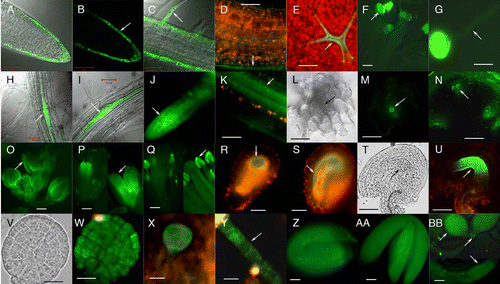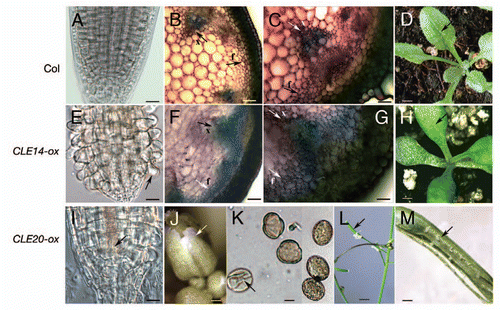Figures & data
Figure 1 The expression patterns of CLE14 and CLE20 analyzed by translational fusion of GFP to the CLE gene; driven by the CLE promoter. (A–G) expression patterns for CLE14. (A, B or C) the root tip (A and B), or root mature region (C) of a 7-day-old transgenic seedling; (D) hypocotyl region of a 7-day-old transgenic seedling; (E–G) GFP signals from a trichome (E), from mature anthers (F) and in a germinating pollen grain from the plant harboring a pCLE14::CLE14-GFP construct. (H–BB) expression patterns for CLE20. (H and I) GFP signals in the lateral root initiation sites of 7-day-old transgenic seedlings; (J) a young lateral root; (K) mature region of a root from a 10-day-old transgenic seedling; (L–N) cross-sections of a 10-day-old transgenic root (L and M) and the inflorescence stem of a 5-week-old transgenic plant (N); (O–AA) CLE 20 expresses in floral organ sepals (O), petals (P), anthers (Q), inner integuments of immature (R and S) and mature (T and U) ovules, developing embryos at the globular stage (V–X), in the suspensor of a embryo at the heart stage (Y), in the mature embryos (Z and AA); (BB) a 3-day-old transgenic seedling. (L, T and V), differential interference contrast (DIC) bright field image; (A, C, H and I) overlay of GFP and DIC images; the remainder are viewed only for GFP. Arrows point to: epidermis in (B and D); a root hair in (C); a trichome in (E); an anther in (F and Q); a pollen tube in (G); lateral root initiation sites (H and I); the RAM in a young lateral root (J); protoxylem of the vascular tissues of the mature roots in (K–M) and stems in (N); a floral organ sepal in (O) and petal in (P); integuments of immature (R and S) and mature (T and U) ovules; suspensor of an embryo at the heart stage in (Y); root meristem, leaf primordia and cotyledons in (BB). Bar = 1 mm in (F, O–Q and BB). Bar = 50 µm for all others. (A–C and H–M) are from Meng et al ().Citation7 The expression analyses of CLE14 and CLE20 were performed as described by Meng et al.Citation7

Figure 2 Overexpressing CLE14 or CLE20 causes multiple phenotypes in Arabidopsis plants. (A–D) Non-transgenic wild-type Col-0 plants (Col). (E–H) Transgenic plant overexpressing CLE14 (CLE14-ox). (I–M) Transgenic plant overexpressing CLE20 (CLE20-ox). (A, E and I) the RAM of root tips of the 7-day-old Arabidopsis seedlings. (B, C, F and G) lignification in the inflorescence stems of Arabidopsis. Hand-cut sections of a living inflorescence stem (10–50 µm section from the top part of the stem adjacent to the oldest silique) of 6-week-old plants stained with Toluidine Blue O (0.05% Toluidine blue O in 0.1 M phosphate buffer, pH 7.0). Lignin stains blue-green. (D and H) 21-day-old Arabidopsis plants. (J) an inflorescence tip; (K) pollen; (L) small siliques; (M) an opened small silique. Pollen from plants overexpressing CLE20 is shown to the left, while wild-type pollen (Col-0) is shown to the right in (K). Arrows in (B, C, F and G) point to interfascicular fibers (f) and to xylem (x). Arrows in (D and H) point to a leaf dense with trichomes (D) or to a leaf with fewer trichomes (H), respectively. Arrows in (E and I) point to a root hair (E) or to the vascular tissue (I), respectively. Arrows point to a small and yellowish floral bud with shortened sepals, petals (J), to wrinkled pollen from plants overexpressing CLE20 (K), to a small silique (L) and to an aborted ovule (M). Bar = 20 µm in (A–C, E–G and I); bar = 5 µm in (K); bar = 2 mm in (D and H); bar = 0.5 mm in (J and M); bar = 5 mm in (L). (A, E and I) are from Meng et al.Citation7 Overexpression of CLE14 and CLE20 were performed as described by Meng et al.Citation8
